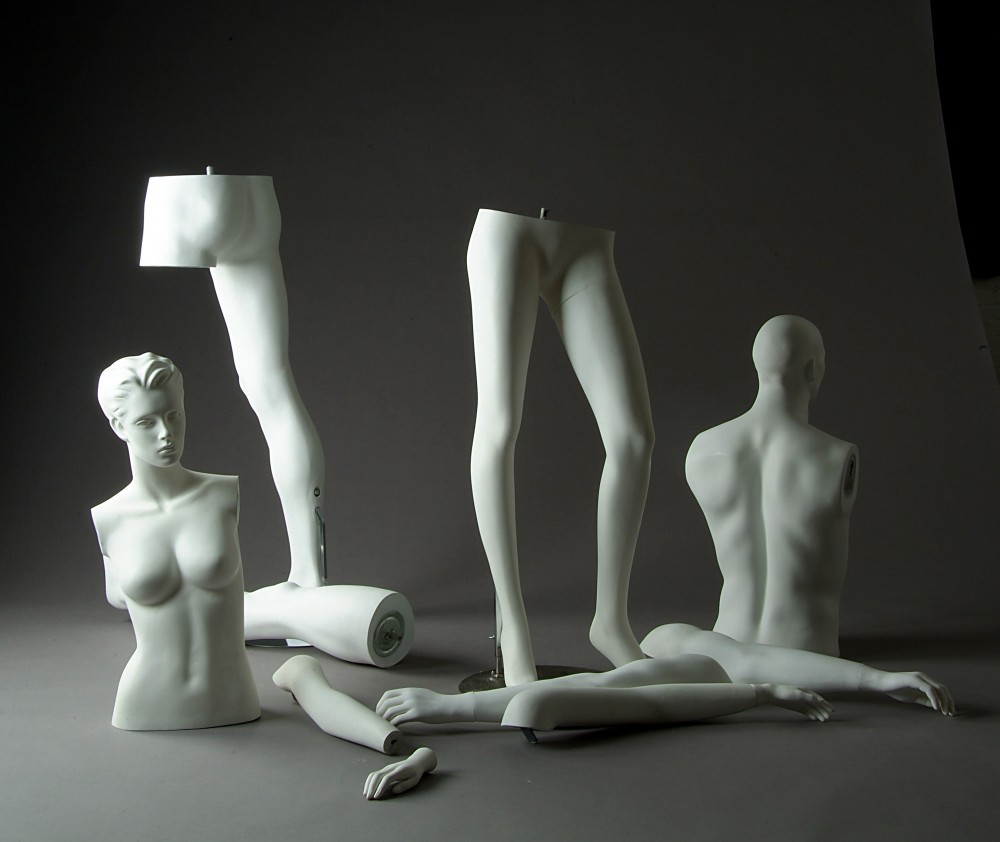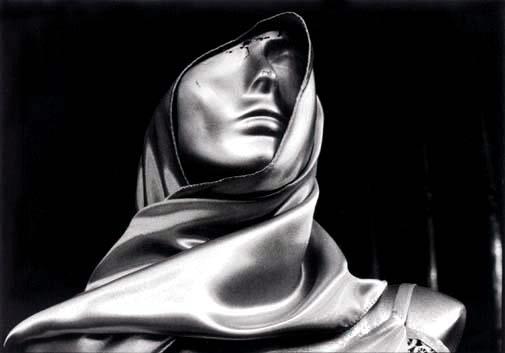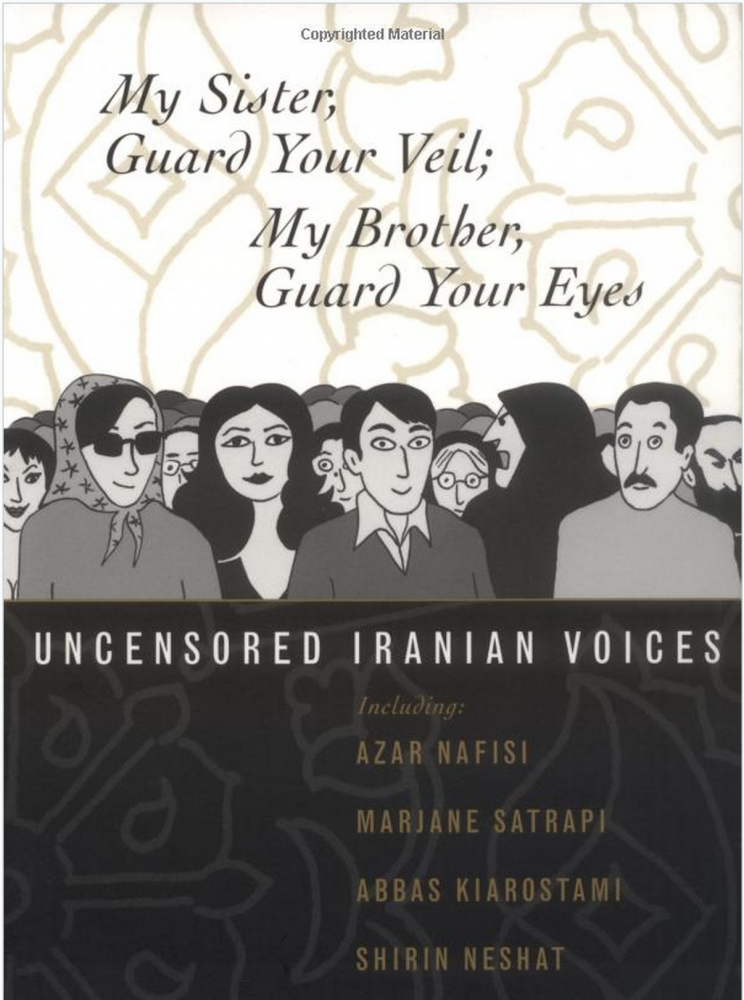
I can never forget the day in Tehran when a few extra inches were added to the short skirts of mannequins in the shop windows. I witnessed with my own eyes armed officials entering a clothes shop. With their guns, they pointed to the naked leg of a female mannequin and stared into the frightened face of the shop owner. That day, I felt like these armed ofiicials were scratching their sharp claws against the most intimate surface of my own femininity. And yet because of such attacks—which were taking place frequently in cities throughout the country—shop owners began to systematically direct all their anger and frustration at the helpless mannequins. They threw the mannequins in storage rooms or locked them up in dark, foreboding attics. This treatment of the mannequins is how I first came to realize that the feminine identity of Iranian women was being violated. The excuse, of course, was the need to protect Islamic laws and revolutionary principles.
It was 1979. Within a few weeks, the mannequins were lined up in the shops with their elongated skirts. Fear was wriggling in their lifeless eyes. Pedestrians, still wearing short skirts, would stop at the windows and laugh at this sudden transformation. I even overheard a stylish young girl whisper to her friend: “They are not powerful enough to make us change our style—that is why they have made the mannequins look more Islamic . . . ,” and she laughed a triumphant laugh.
In reality, these female mannequins—these inanimate women—were the reporters of the changes that were transpiring in our lives. As a young woman who had received a political and criminal law degree from Tehran University, as a curious journalist and a member of the Iranian Bar Association, I was particularly interested in observing the effects of these political measures on our everyday lives. The mannequins and the alterations in their appearance became my passion during the very hard and lonely years of the revolution. I felt united with these dolls. The mannequins somehow accurately reflected the systematic aggression against our individual identities. I would talk to these dolls, and I duly wrote down what was happening in their lives. These notes gradually turned into the tale of a series of events that would define the nature, helplessness, and resistance of women under the storm-like attacks that were carried out against them.

The story began when, having deposed the shah’s regime, religious leaders insisted on the necessity of women donning the Islamic veil. Meanwhile, these leaders barred female judges from exercising their profession and repealed the Family Protection Act, which guaranteed women the freedom to work, travel, and divorce at will. This provoked anger and rebelliousness among women, even though, in those early years, not all Iranian women were united in the quest for regaining their rights.
Enforcing the Islamic veil as compulsory attire was the most significant step in a succession of laws against women in the first years of the revolution. Before this happened women dressed freely and, in Tehran and other major Iranian cities, many women even followed Western fashion. Both veiled and unveiled women enjoyed a peaceful life; both were respected for their beliefs. The unveiled women were not socially restricted, and they were required to wear the veil only when entering mosques or other holy places. Young girls and women could appear with or without the veil in educational centers and workplaces. Thus it was this unwritten agreement—which was compatible with every principle of international human rights—that was broken in a historic moment.
Women who were not wont to wear the veil did not immediately follow the orders of the leaders of the Islamic revolution. It was a few years before we accepted it—and then we did so essentially out of fear. The female mannequins were the first group of unveiled women in Iran who were forced to wear Islamic veil. And these mannequins slowly made us realize that the social and political history of our country was being turned on its head.
In the beginning, however, the overnight change in the mannequins’ outfits had not appeared portentous enough to compel Iranian women to wear the veil. So splashing acid on the face and bare skin of women’s bodies became a practice of the regime. The print media—which wasn’t yet the target of the newly established “governmental censoring centers”—started to inform Iranians of these violent incidents. The shadow of fear had already stolen the glow of hope from countless young girls and women. Iranian women were gradually feeling that, in the eyes of the new regime, they were nothing but lifeless objects with no agency of their own: objects that official and unofficial authorities could invade day and night. The ruling fundamentalists, in effect, considered the individual identity of women as the most perilous threat to their enduring power. Accordingly, they needed to destroy that identity so that their rule would last for centuries to come.
Rumors spread rapidly. Some women believed that the regime’s brutal restrictions were merely reactions to the shah’s policies of hastening Western-style reforms in the previous years. Others warned that unveiled women had simply become a tool the authorities used to conjure an atmosphere of fear, with the pretext of protecting women’s chastity. Such policies, many whispered, were preparing the nation for further repression against the opponents and critics of the Islamists. Meanwhile, the mannequins–who knew nothing of the government’s strategic plans to enforce the veil–were still attracting customers with their alluring hair and curvaceous bodies.

The war between Iran and Iraq broke out in 1980. This war targeted Iranian women’s identities just as the Islamic revolution had. Young boys were drafted and required to write their testaments be before they left for the front. After their martyrdom, the authorities would publish these testaments–in nearly all of them, the martyrs had ordered women to observe the Islamic veil. Their orders turned to slogans and were inscribed on the walls of the cities.
They read: “My sister, your veil is even more powerful than my blood. Signature: the martyr.”
The atmosphere in Iran was one of terror and repression. The revolution and the war washed away all the colors of our lives. Mannequins grew bald, leaving their luscious hair behind in storage rooms. Women, in turn, hid their hair under the imposed Islamic veil. Mannequins had resisted for months before losing their free-flowing hair; for a while, they had even tried to content the martyrs by wearing small triangular headscarves. But those small scarves were not enough. The ofiicials—claiming to protect the martyrs’ blood——sat in their SUVS and established the “mobile Islamic moral courts.” These mobile courts would destroy unveiled female mannequins and detain women. Their officials would tear apart the unveiled mannequins and force women to lie down on torture beds to be whipped with dozens of lashes for not wearing the proper Islamic garb.
Iranian feminism has grown from the scars of these lashes on women’s bodies. It is deeply rooted in the suffocated screams of Iranian women throughout the years. And as a result, the fundamentalists have now begun to dread the feminist explosion that is well on its way.
After the hair was lost, only the the roundness of women’s faces, their daintily colored lips, their blushing cheeks, and their adorned eyelashes remained visible. But the authorities could no longer tolerate these attractive faces, so they continued the Islamization of women’s looks, with a little help from the mannequins. These mannequins were turned into role models for Iranian women: they were already veiled, but this wasn’t enough. Tradesmen, alarmed by the drastic repression, took action in accordance with the new Islamic orders. Gradually, the color of the mannequins’ faces faded away. The rouge of their Iipstick and their blush evaporated. Their eyes started to appear dead and hollow. A sense of fright nested in their gaze that bore little resemblance to the air of modesty and chastity the Islamic Republic wished to summon. It did not take long for these mannequins to adopt the role of leaders of the repressed women. Ironically, as we morphed into Islamic-looking women, we obeyed a bunch of lifeless dolls. New values were being measured on their bodies first. The shop owners were constantly reducing and severing femininity, in keeping with orders. Mannequins had lost their main raison d’etre to become sheer religious and political instruments. The sparkle of cheerfulness had fled their style. The enthusiasm for interacting with the opposite sex was waning among the people. Any attempts to look attractive brought about a sense of sinful dread and guilt. The colors black, brown, dark blue, and gray had conquered the world, it seemed—although among its glum siblings, red had managed to survive as the symbol of the martyrs’ blood. It was the messenger of the repressive orders and reminded women of the lack of charm and bliss in their lives.
On the surface, it was as though modernity had given in to religious tradition. Foreign observers flocked to Iran with journalist visas, exploring the religious centers of political power and the depressed atmosphere of the cities. They were the reporters of the darkness and sorrow that weighed on the transformation of Iranian society. They introduced Iranian women to the World as masses of Islamic-looking shadows represented by the color black. journalists from all over the world were reporting the Islamic government’s aggressive methods and its projects for the separation of the sexes in careers and educations. And for fear of the regime, people never let these reporters into their private gatherings. Thus for many years, the world remained unaware of the conflicting public and private mores in Iran. They believed that Iranians had detached themselves from music, dance, singing’ happiness, and their individual identities. They had no idea what was going on behind closed doors. The lifeless mannequins and sad pedestrians became the customary targets of cameras. A fictitious image of Iranian women was introduced to foreign eyes.
The owners of the clothes shops finally came to the conclusion that might be better off detaching the heads of the mannequins from their bodies altogether. The authorities were claiming that the lips of women were aphrodisiac and their eyes stimulating. The shop owners were confused and did know what to do to save their businesses from the attacks of the regime. So all of a sudden, they cut the heads off their mannequins. A diagonal surface replaced the necks of these beheaded dolls, on which the owners had now thrown long and dark scarves. Their spongy breasts were slashed from their bodies. Instead, the owners installed two little coils on the empty spots, so that the “feminine gender” might modestly be suggested beneath the ample Islamic garments. The coils displayed the mutilated gender of the mannequins.
These beheaded mannequins were left with only a round face made out of cardboard. They had no eyes, no eyebrows, no noses, no mouths. The ideal woman for fundamentalists was a woman who did not have eyes to see, a tongue to speak, and legs to run away. The shop owners then chopped off the fingers of the female mannequins and replaced their hands with narrow, extended plastic cylinders. Thus they one and for all obliterated every aspect of feminine identity and appearance: lush hair, groomed nails, coal-black eyes, suggestive glances, and scarlet lips.
For many years, foreign journalists never knew that liberty, the pursuit of happiness, modernity, entertainment, and even interactions with the opposite sex existed under the cold and repressed surface of the cities. It took two decades fro the world to learn about the schizophrenic existence of the people of Iran, and especially about the resistance of Iranian women. The schizophrenic lifestyle in IRan then became world news. People in Tehran and other cities began to voluntarily invite foreign journalists to their private gatherings. Slowly, the notion of feminism, which had not been fully assimilated by Iranian society, managed to sashay its way through the tortuous labyrinth of the regime. Feminism thrived under women’s chadors and their imposed Islamic garments. It surreptitiously grew strong. Women learned the secrets of defending their individual identities. They confounded the enforced values and created their own fashion out of the Islamic veil. Garments were cut shorter and their colors shifted to brighter tones. In 2005, dark pink was high fashion in Iran. And the material of Islamic clothing is now more delicate than it ever was.
These changes have taken as long as twenty-six years to occur. But women’s needs and demands are not met, evidently, by merely tailoring shorter, tighter, brighter, or softer garments. To this day, Iranian women have continued to be severely harmed by the regime through sexual discrimination and violent punishments such as detainment, flogging, mutilation of hands and feet, and stoning to death.
In Iran’s official language, Farsi, there is no act “feminism.” And a group of Iranian sociologists claims that, of approximately 30 million women who live in Iran, a total of 29 million have never heard the word “feminism” in any other language either. The circulation of books with feminist content does not exceed two thousand copies, and on International Women’s Day, in March of 2005, only about two thousand women attended a public gathering. No matter—although only tacitly, feminism has now begun to define itself in the individual and social behavior of Iranian women in their everyday lives. So much so that Islamic fundamentalists have become quite helpless in bridling feministic tendencies and seem unable to restrict the feminist demands of their own wives, daughters, and sisters.
The signs of this social agitation are apparent in the country’s national statistics. More than 60 percent of applicants currently admitted to universities are women. At the same time, the rates of divorce and “fornication”—which is considered a crime in Iran—-are rapidly increasing. The rate of marriage has steadily decreased over the years, and the soaring incidence of prostitution and female drug addiction has caused enormous distress among fundamentalists.
Today, both religious and nonreligious women are bent on regaining their individual identity and freedom. Those who adhere to the principle of a religious government are striving to unearth feminist concepts in Islamic texts. And those who are advocates of the separation of religion and state parade their feminine identity using Western symbols and social attitudes.
They also tirelessly fight to keep their lives private and out of sight of governmental agents. Overall, these two groups of women have inched closer to their ultimate goals throughout the years. They criticize the current situation and claim their rights. They express their dissatisfaction through individual and collective reactions to the regime, without much heeding its threats.
In 2005, precisely on International Women’s Day, a symbolic assembly of Iranian women announced its demand for changes in the Islamic constitution as its first effort to regain stifled rights. The demand, in and of itself, was significant, demonstrating that Iranian women are willing to publicly tear apart the layer of religious tradition that oppresses them. In fact, their presence in the unofficial job market as vendors, cashiers, waitresses, operators in cab services, real estate dealers, owners of convenience stores and other shops is increasing. Inflation and high prices, rising number of single mothers, and the lack of social protection have incited women to join the job market and have thus noticeably modified the masculine appearance of Iran’s cities.
My belief is that that it won’t be long until the day Middle Eastern women are stirred by a new women’s movement-one that has risen from the land of Iran, from the pain, sorrow, and bruises of our revolution. My belief is that it won’t be long until our mannequins start looking, once again, like our sulfurously modem mannequins of times past.


